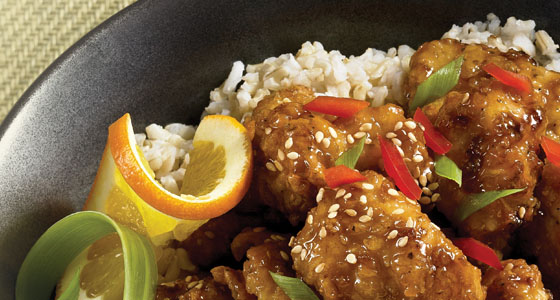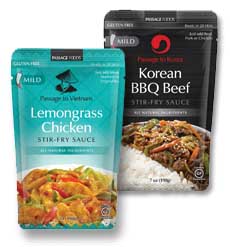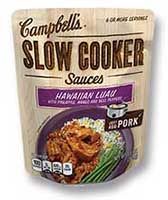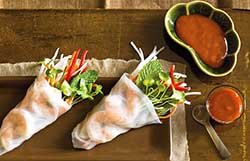Sauces Satisfy and Surprise
A growing array of sauces and marinades addresses consumers’ desire for authentic, exotic, and ethnic fare that is easy to prepare.

While taking a tour of the test kitchens at P.F. Chang’s headquarters in Scottsdale, Ariz. (http://www.pfchangs.com), you learn that the first step in the creation of any restaurant menu item is a search for a great sauce. Sauce development is primary because the wok is central to all of the cooking at P.F. Chang’s and the company’s fast-casual spinoff Pei Wei Asian Diner. Sauce is serious business—a construction of bold, concentrated flavor that is what keeps customers coming back—and, unlike other kinds of sauces (e.g., barbecue or pasta), each Southeast Asian-inspired concoction must be carefully crafted to be just the right balance of tangy, sweet, salty, and heat. Pei Wei Creative Culinary Chef Phil Butler says, “Sauce is what brings everything together, and everything in the sauce has to be in harmony.”
 Now Pei Wei is breaking new ground with the announcement that it’s made one of the largest menu overhauls in the history of the restaurant, according to Butler. “Lighter, brighter, and fresher” looks to be the underlying theme of the new menu. On the menu, customers will have their choice of lighter, small-sized entrées. A new Thai Lime & Chile offering combines citrus flavors with spicy Fresno chiles and is available as a regular or small wok-prepared entrée or as an entrée salad. Other menu additions include Wok Roasted Vegetable Salad, and new side dishes include zesty Ginger Orange Edamame and spicy Szechuan Green Beans. The menu also has a new platform: “Lettuce Wraps” are not just an appetizer anymore and are now part of the “Lighter Offerings” section of the menu—a clear signal that the company looks to expand and own this category. Varieties include Traditional Chicken, Thai Chicken, and Korean Steak.
Now Pei Wei is breaking new ground with the announcement that it’s made one of the largest menu overhauls in the history of the restaurant, according to Butler. “Lighter, brighter, and fresher” looks to be the underlying theme of the new menu. On the menu, customers will have their choice of lighter, small-sized entrées. A new Thai Lime & Chile offering combines citrus flavors with spicy Fresno chiles and is available as a regular or small wok-prepared entrée or as an entrée salad. Other menu additions include Wok Roasted Vegetable Salad, and new side dishes include zesty Ginger Orange Edamame and spicy Szechuan Green Beans. The menu also has a new platform: “Lettuce Wraps” are not just an appetizer anymore and are now part of the “Lighter Offerings” section of the menu—a clear signal that the company looks to expand and own this category. Varieties include Traditional Chicken, Thai Chicken, and Korean Steak.
These introductions all have to do with the latest in customer preferences and sauce trends. “People are getting really focused on flavor, health, and regionally specific dishes,” Butler says.
Many of these customers also have their minds set on bringing healthy, regionally specific Asian flavors of cooking sauces home to use in their own kitchens. A new Mintel report titled Cooking Sauces, Marinades, and Dressings—U.S. says the market enjoys a healthy outlook, having reached $7.4 billion in 2013, and is expected to reach $9.1 billion by 2018. According to the report, dry sauces topped all segments of the category with an estimated $3.2 billion in sales in 2013, while dressings sold $2.6 billion, and liquid sauces sold $1.6 billion. Leading the dry sauce segment is McCormick, Baltimore, Md. (www.mccormick.com), with $1.2 billion in sales and 18% share of the market.
When Mintel asked 1,763 Internet users ages 18+ what flavors they preferred when choosing “sauces/marinades, dry seasoning mixes, or dressings,” four in 10 respondents reported that they preferred “international/ethnic flavors.” Mintel suggests that these findings underscore the “growing popularity of more exotic flavors that source from faraway lands.” Because five in 10 respondents also reported that they preferred “spicy/hot” flavors, Mintel advises that consumers are very likely to enjoy not only hot and spicy, but also international/ethnic flavors and authentic regional flavors. Indeed, ethnic foods prepared at home are on the rise; more than 87% of Mintel survey respondents reported that they are cooking ethnic foods in their home more frequently.
--- PAGE BREAK ---
 Passage to Ethnic Sauces
Passage to Ethnic Sauces
Mark MacKenzie, Managing Director, Passage Foods North America, Collinsville, Conn. (www.passagefoods.com), has witnessed the growth of the ethnic cooking sauce category in the United States firsthand since his company first pioneered the market. “Asian is no longer Chinese food,” MacKenzie says, “it’s Vietnamese and Malay.” He adds that within the past 18 months, “the category has just exploded.”
The company has expanded its line to 22 different liquid cooking sauce products. The latest introduction is Passage to Indonesia Satay Chicken Stir-Fry Sauce, no doubt to meet the increasing interest of customers for more regionalized cuisines. The satay sauce represents one of Indonesia’s national dishes with a blend of peanut, chili, and other flavors associated with of the island of Java such as coriander, cardamom, cumin, clove, and nutmeg.
MacKenzie says the key drivers of these new regionally inspired products are a younger generation that is more adventurous in their food tastes. These customers include young professionals, the majority between the ages of 22 and 34, who are eating out at ethnic food restaurants (including Asian, Mexican, and South American establishments), watching food and travel shows on television, and wanting to diversify the way they eat. With an eclectic taste for ethnic food, consumers have also led other companies to enter the market. Far from being a concern, MacKenzie says that the healthy competition has really expanded the category. “It’s dramatically helped us develop as a brand,” MacKenzie says. “We are happy to see other brands entering the simmer sauce category as it is increasing overall awareness with the consumer. We really feel that Campbell’s and Frontera have done a very good job in helping expand the cooking sauce category.”
One of the ways Passage Foods has responded to competition is by focusing on quality. A good example, according to MacKenzie, is Passage to Vietnam—Lemongrass Chicken Stir-Fry Sauce. “You can’t fake lemongrass flavor,” he noted. “It’s an expensive ingredient and most food developers are driven to bring costs down. The trick is to figure out the balance.” In addition, the company has focused on product design and marketing claims that most appeal to its target market; such claims include “ready in 20 minutes,” “restaurant quality,” “all-natural ingredients,” and “certified gluten-free”.
“Convenience is driving the category because consumers don’t have time to prepare sauces from scratch, but they still look for authentic ingredients, clean labeling, and health claims,” MacKenzie says. “There are health decisions being made. The consumer is willing to pay a reasonable premium for a quality product.”
Among other stir-fry sauces that Passage Foods offers are Passage to Thailand—Pad Thai, Red Thai Curry, Tom Yum, and Thai Basil & Sweet Chili; Passage to Japan—Teriyaki Chicken; Passage to Korea—Korean BBQ Beef; and Passage to China—Honey, Soy, & Garlic. The company also specializes in simmer sauces including Passage to India—Korma, Butter Chicken, Tikka Masala, and Rojan Josh; Passage to Morocco—Spiced Honey Tagine and Spiced Lemon Chicken; and Passage to Mexico—Chipotle Lime, Ranchero, and Veracruz.
--- PAGE BREAK ---
 At Home and Abroad
At Home and Abroad
Campbell’s, Camden, N.J. (www.campbellsauces.com), is expected to continue to expand the category of cooking sauces. In this year’s Campbell’s Culinary TrendScape Report the company noted the growing interest in distinctive flavors both at home and abroad, global fusion flavors, and an emphasis on nutrition, including protein and more fruits and vegetables. Additionally, Campbell’s is keen on moving into supplying slow-cooker sauces, which represent a growing segment of the cooking sauce category with more consumers looking for spicy Asian and Latin American options. After all, the company reports that more than 80% of households own slow cookers. According to Darren Serrao, Senior Vice President of Innovation for Campbell’s North America, a new line of slow-cooker sauces will make it easier for “home cooks to expand their weeknight culinary repertoire with flavors inspired by restaurant dishes and global flavor trends.” Among the new Campbell’s offerings are Sweet Korean BBQ with Roasted Ginger and Sesame; Hawaiian Luau with Pineapple, Mango, and Bell Peppers; Mexican Red Chile Taco with Garlic and Sweet Peppers; and Moroccan Spiced Stew with Green Olives and Lemon. Each pouch provides enough sauce for two-to-three pounds of meat, serving six or more people.
Pushing Boundaries with Flavor
Magda Dziembowski, Industrial Marketing Specialist at Kikkoman Sales USA Inc., San Francisco, Calif. (www.kikkomanusa.com), believes that more and more brands will also begin chasing the trend of “transparency” by more prominently touting their authenticity and ingredients on packaging. She says the right flavor matters too. “While cooking shows push boundaries by showing us what’s eaten in remote regions of the world, it’s turning us into more adventurous eaters,” says Dziembowski. “You can eat anything with the right sauce on it, right?”
On the world stage, two ready-to-use liquid sauces that can’t be ignored are sriracha, leading the way, and gochujang, following close behind. The reason why these flavors are so well-liked, says Dziembowski—apart from the fact that they taste great—is that they are seen as “authentic,” simply made, and healthy. “People are looking at the ingredients on labels, and not just the fat and calories anymore,” she says. Kikkoman has been in the business of providing authentic ingredients and simply made sauces for more than 300 years, Dziembowski explains. “Our core product has four simple ingredients—water, wheat, soybeans, and salt—and is naturally brewed,” she says. The company constantly adds sauces to its retail line-up and pays close attention to trends. Now, according to Dziembowski, the company is finding tremendous success with its new introductions of Kikkoman Preservative-Free Orange Sauce and Kikkoman Sriracha Hot Chili Sauce. Yet she stresses that naturally brewed soy sauce, with its full umami flavor notes and full-bodied taste, is truly the “magic ingredient” that will help food manufacturers most easily and inexpensively make a sauce or dressing more satisfyingly delicious.
Steven Padley, Corporate Chef/Manager Culinary Research & Development for Wixon, St. Francis, Wis. (www.wixon.com), believes that “sriracha is going to be hot for the next 18 to 24 months. It has not gone through the entire trend life cycle yet.” He also believes Korean and Vietnamese sauces are really starting to come on. He says that what will be interesting is to see if there’s a return to authentic flavors in ethnic or a fusion with regional American sauces. “If you look at the use of gochujang from Korea and fish sauce from Vietnam, these are being fused into more classic American sauces,” he says. Some of that is going on in restaurants now as Southeast Asian flavors fuse with traditional American foods. “As these become more common, you will see flavor options increase and get in sync with hot flavors that are current,” Padley says.
Wixon focuses on helping food manufacturers create custom solutions with quality ingredients and supporting clients with natural, clean label ingredients and flavors. Padley says that if cost is an issue, artificial ingredients can be used, although only at the request of the manufacturer. The company mainly focuses on creating flavor systems that include spice blends or sauces that can enhance the savory profile in meat dishes. As the trend for intense flavors in sauces as well as convenience continues, Padley says that “something to watch out for is pork” along with the reinvention of sour flavors in sauce with the use of vinegars where they have not traditionally been used.
 Custom and Private Label
Custom and Private Label
When looking for gourmet or high-end sauces for foodservice, restaurants, or retail, food developers can turn to the professionals for customized solutions. One of these companies is Cuisine Solutions, Alexandria, Va. (www.cusinesolutions.com). The company offers customized solutions for food developers with a product line that includes Fire-Roasted Pepper Sauce, Lentil Chili, and Shahi Paneer. Park 100 Foods (www.park100foods.com), Morristown, Ind., also offers several sauce options that can be customized including ready-touse Mexican, Southern, Jamaican, Cajun-styled, and Teriyaki offerings. In addition, Schlotterbeck & Foss, Portland, Maine (www.schlotterbeck-foss.com), helps companies create recipes with a strategy that is right for their brands, and they offer several spicy and savory sauces that include Teriyaki, Ginger Teriyaki, Garlic Teriyaki, Sesame Teriyaki, Tequila Lime, Pineapple Jalapeño, General Tsao, and Raspberry Chipotle. Private-label manufacturer Bay Valley Foods, Platteville, Wis. (www.bayvalleyfoods.com), a division of TreeHouse Foods, recently introduced ready-to-use simmer sauces. That line-up includes Tikka Masala, Butter Chicken, and Yellow Curry. These are in addition to Bay Valley’s existing line of Asian (including Indian, Thai, Chinese, and Japanese), South of the Border (including Baja Chipotle and Caribbean Jerk), Hot (including classic and wing sauces), Mediterranean, and American sauces. The company has also introduced new slowcooker sauces including Garlic Chicken, Cacciatore, and Pot Roast.
--- PAGE BREAK ---
Getting the Consistency Right
Apart from the balance of flavors in any cooking sauce, is the need to achieve the right consistency in order to deliver a pleasing mouthfeel. No cooking sauce is complete if it doesn’t have the right texture and stability. New product introductions of cooking sauces over the last year, especially those with spicy and bold flavors tailored to Millennials, have caught the attention of Angelina De Castro, Marketing Manager, Savory, with Ingredion Inc., Westchester, Ill. (www.ingredion.com). The company provides specialty starches that are versatile and cost-effective for use in thickening and providing texture that can help greatly with cling, mouthfeel, creaminess, and melt-away—all factors that can be just as important as sauce flavor. “Our line of Precisa® Optimized texture systems helps sauce manufacturers in formulating better-for-you products, reducing fat or oil, while mimicking the organoleptic properties of fat, and maintaining premium texture,” De Castro says.
For clean label products, De Castro adds, the company offers the Novation® range of functional native starches that can deliver the same processing benefits of traditional modified starches, like heat resistance, but with a consumer-friendly label declaration. Homecraft® Gold also is a clean label texturizer that provides sauces with a rich appearance, smooth texture, and creamy mouthfeel without compromising shelf-life stability.
 Some starches are also modified to act as emulsion stabilizers, keeping oil and water from separating in sauces. Janet Carver, Ingredion’s Culinology Group Manager, developed a series of mayonnaise-based cooking sauce concepts using Ingredion texturizers including N-Creamer 46, which stabilizes emulsions during a sauté or simmer. According to De Castro, the use of mayonnaise in any type of simmer sauce for the home consumer has not been achieved until now. The new concept makes it possible to more easily formulate simmer sauces for the home consumer.
Some starches are also modified to act as emulsion stabilizers, keeping oil and water from separating in sauces. Janet Carver, Ingredion’s Culinology Group Manager, developed a series of mayonnaise-based cooking sauce concepts using Ingredion texturizers including N-Creamer 46, which stabilizes emulsions during a sauté or simmer. According to De Castro, the use of mayonnaise in any type of simmer sauce for the home consumer has not been achieved until now. The new concept makes it possible to more easily formulate simmer sauces for the home consumer.
Bringing It All Together
It’s said that the primary purpose of a sauce is simply to accompany a primary ingredient or ingredients. But if it is to be the magic, or glue, that brings meat, chicken, and/or vegetables together—as it is intended in Southeast Asian cuisine—than it must truly imbue balanced flavor. Yet how does a food developer really know if something has gone wrong? Butler would say that it’s when something doesn’t seem to be in balance. Something could be missing or not supplied in sufficient amounts. What’s not there? Is it sweetness, saltiness, tang, savory attributes, or aroma? None of these can be deficient, none can be overpowering. A sauce must also deliver the ideal consistency. If it does not, then no matter how wonderfully balanced it is in flavor, a sauce can be ruined. How to obtain the right texture? That can be a matter of trial and error. Is the sauce thickened enough or are ingredient particles too large for the suspension? All of these factors are up for consideration. For ultimate enjoyment, the most satisfying of sauces will stimulate each of the senses and deliver the most pleasing tastes/textures to the mouth.
At times, the perfect blend of flavor and texture can be in the mouth of the beholder. Sauce creation is every bit as much an art form as painting or music with just as rich a history. A lesson in balancing flavor is learned from a beautifully expressive and ancient Chinese description, attributed to chef I Yin (239 BCE) and found in Harold McGee’s On Food and Cooking: The Science and Lore of the Kitchen: “In the business of harmonious blending, one must make use of the sweet, sour, bitter, pungent, and salty. Whether things are to be added earlier or later and in what amounts—their balancing is very subtle and each thing has its own characteristic. The transformation in the cauldron is quintessential and wondrous, subtle and delicate. The mouth cannot express it in words; the mind cannot fix upon an analogy. It is like the subtlety of archery and horsemanship, that transformation of Yin and Yang, or the revolution of the four seasons. Thus [the food] is long-lasting yet does not spoil; thoroughly cooked yet not mushy; sweet yet not cloying; sour yet not corrosive; salty yet not deadening; pungent yet not acid; mild yet not insipid; oily-smooth yet not greasy.”
David Despain,
a member of IFT, is a freelance writer
and nutritionist based in Gilbert, Ariz.
([email protected]).
